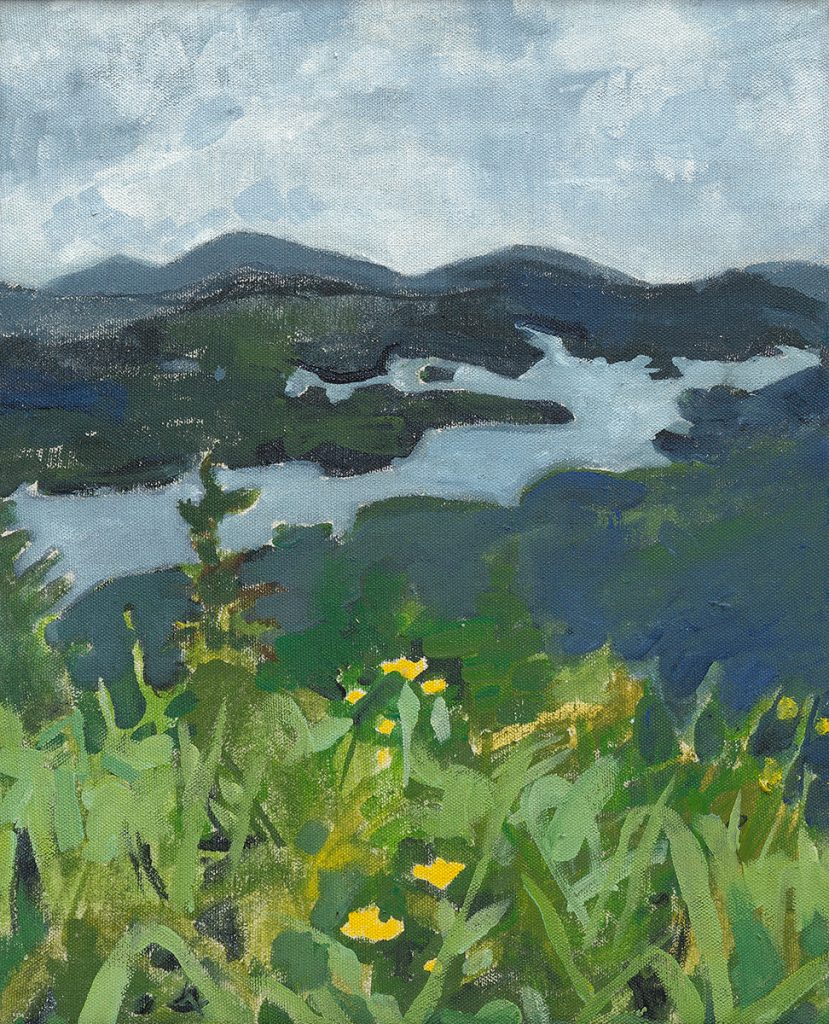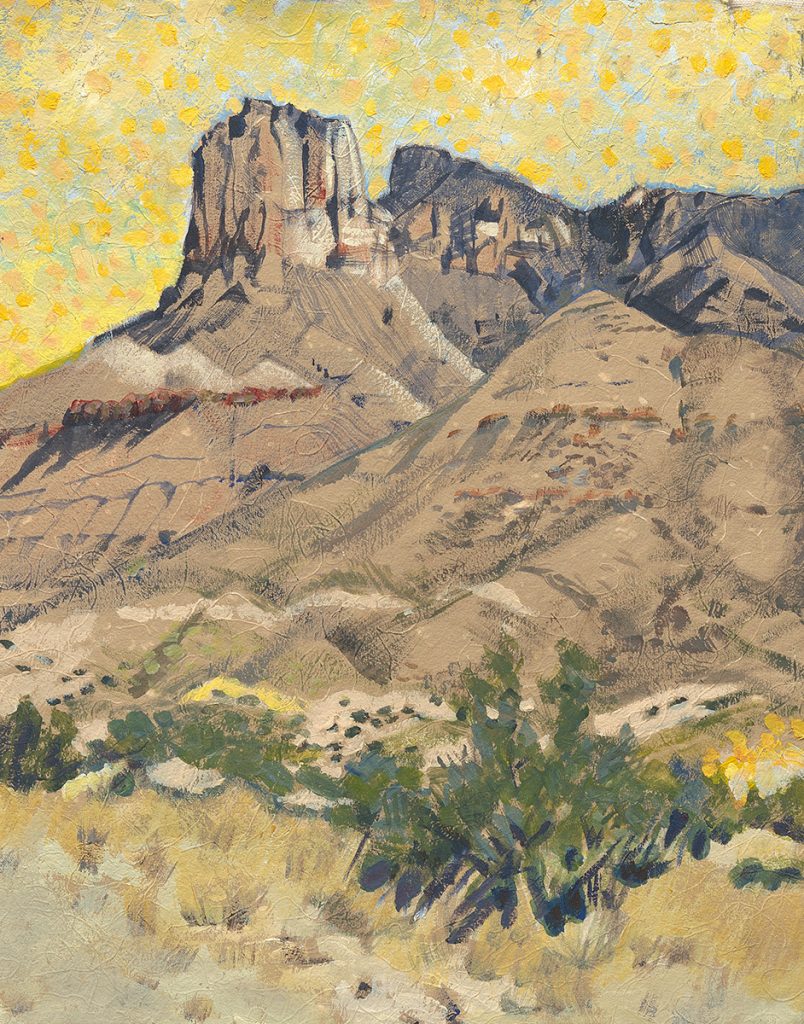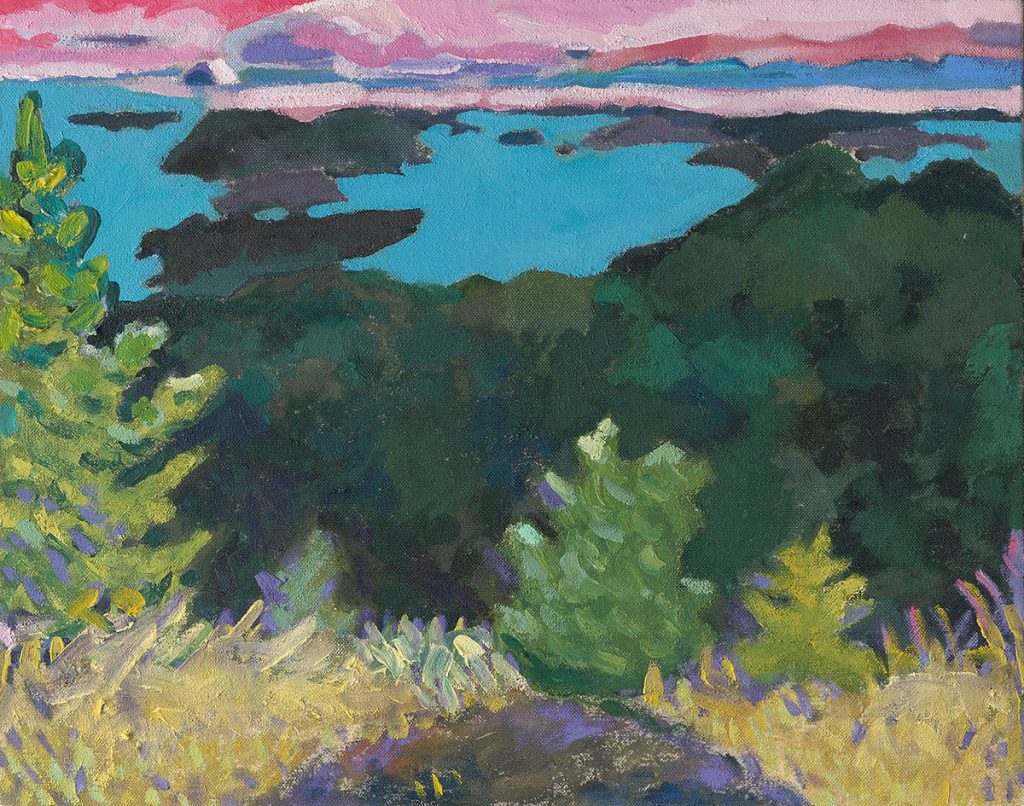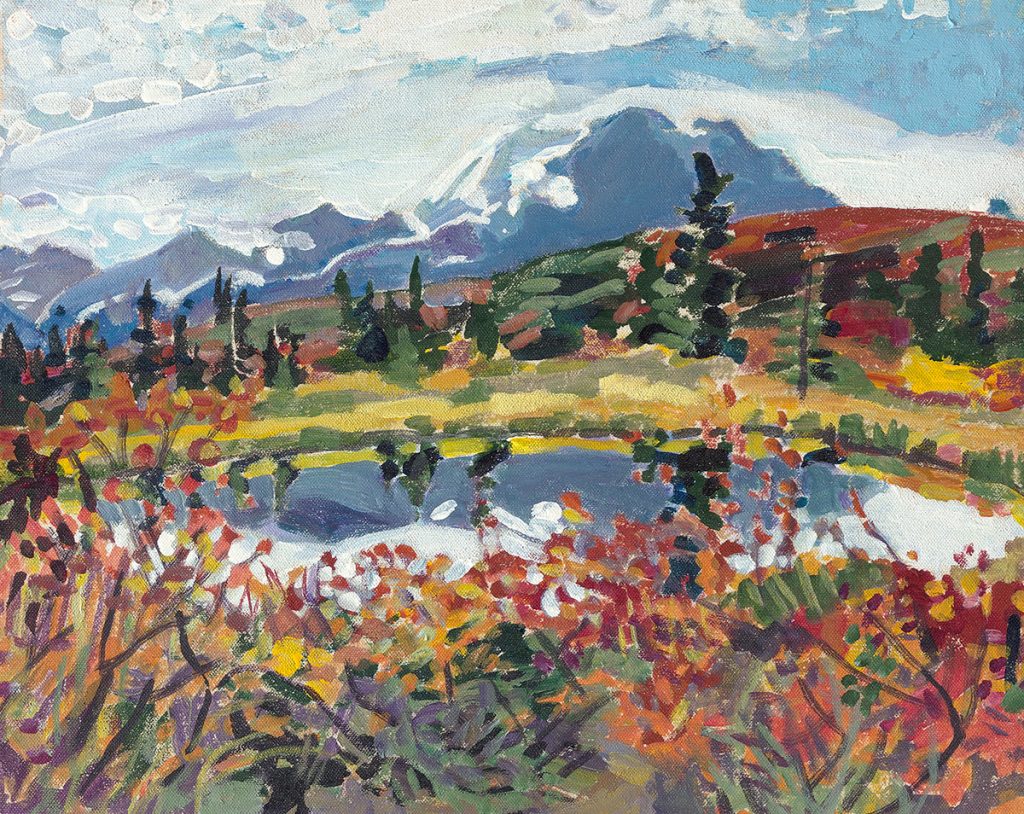Land America Leaves Wild: An Introduction
Art has always had a celebratory function. It has feted the glory of the gods, the purity of an aesthetic ideal, and the appearance of a person. It has commemorated the coronation of an emperor, the birth of a child, and the importance of a religion. It has also applauded victory in battle, the wealth of patrons, and the capability of materials. And across cultures and times, art has also celebrated nations and landscapes.
With this series of paintings of “land America leaves wild,” Diana Wege celebrates America’s stunningly diverse wilderness areas and the unique American foresight that has preserved these places. In a nation of often conflicting ideas about land use and environmental stewardship, she lauds the underlying value Americans still place on land left alone. This series of paintings and this volume, she says, are a paean to Americans for the esteem in which they hold wilderness.

50 States Series: Vermont
Art has always had a celebratory function. It has feted the glory of the gods, the purity of an aesthetic ideal, and the appearance of a person. It has commemorated the coronation of an emperor, the birth of a child, and the importance of a religion. It has also applauded victory in battle, the wealth of patrons, and the capability of materials. And across cultures and times, art has also celebrated nations and landscapes.
With this series of paintings of “land America leaves wild,” Diana Wege celebrates America’s stunningly diverse wilderness areas and the unique American foresight that has preserved these places. In a nation of often conflicting ideas about land use and environmental stewardship, she lauds the underlying value Americans still place on land left alone. This series of paintings and this volume, she says, are a paean to Americans for the esteem in which they hold wilderness.
Over a period of twenty-five months Wege visited twenty-four national lands and Nature Conservancy properties. Wanting to paint different kinds of landscapes, she chose her sites in a variety of ways. Sometimes she conferred with the Wilderness Society (Escalante National Monuments in Utah); sometimes she or her traveling companion “always wanted to go there” (Boundary Waters Canoe Area in Minnesota); and some sites were near friends she wanted to visit (Green Mountain National Forest in Vermont). She went to Wyoming because she wanted her seven-year-old son to ride horses there as she had done at that age, to Arkansas because of a chance encounter in an airport, and to Washington’s San Juan Islands National Wildlife Refuge because of a book she holds dear. And sometimes the choice, she says, was “serendipity.”
Her intention was to rejoice in the rich landscapes she found. Working from a Wilderness Society map, she went first to Boundary Waters Canoe Area in Minnesota. This was April 1996; as a kayaker she had always wanted to go there. At this time Wege was a conceptual artist whose work had strong symbolic links to literature. Thus when she left for Boundary Waters she had “no idea” of how she was going to express her admiration for these lands. She took with her small blank canvases, paints, and some drawing pads, planning to do small conceptual works. “I spent the first day in a lodge on the lake and drew the view out the window.” Wege found that the straightforward depiction of what was before her was enough to declare her regard and respect for the land; no symbols were necessary. “I never used any tool but the visual to express what I wanted to express.”
Diana Wege did a number of small pencil sketches from her window the first day at Boundary Waters. Later, she painted six acrylic paintings. When she returned to her studio in New Canaan, Connecticut, the following week, she pushed together the four most successful works she had done, and this four-panel layout became the format for the subsequent work in the series.

This pushing together of four paintings was just the beginning of the job, however, for now that the four canvases were to be seen and framed as one, they had to be made to perform together aesthetically. So, in her studio, Wege’s rich, painterly vocabulary took over. Here she took her reverential depictions of beautiful wild lands and made them also into aesthetically taut, personal celebrations of color, form, and texture, using all her artistic power to communicate not only what nature looks like but also the appeal nature has to our emotions.
Thus from the first piece in this series Diana Wege had her plan: her goal was to celebrate the American value that set aside natural lands; her format was four small panels (usually acrylic underpainting with oil on top) brought together as one (sometimes horizontal, sometimes vertical); and her style featured rich color, expressive line, and eloquent brushstroke. Her mode of working respected equally the natural site (“I can’t lie when I’m at the site”) and the creativity of her art (“When I’m in the studio I say to myself, ‘I’m making it into a panning now. Now I can make changes.’”).

50 States Series: Texas and New Mexico
In May 1996 she went to Texas and New Mexico and painted Guadalupe Mountains National Park and Carlsbad Caverns Wilderness; from June 1996 to April 1997 she was in the Green Mountains National Forest four times; between these visits she traveled to Pictured Rocks National Lakeshore in Michigan’s Upper Peninsula, the Absaroka Range of Shoshone National Forest in Wyoming (August), Ozark National Forest and Mark Twain National Forest in Arkansas and Missouri (October), San Juan Islands National Wildlife Refuge in Washington (November), Ninigret National Wildlife Refuge in Rhode Island (January), and the Adirondacks, the Catskills, Fire Island National Seashore, and Ward/Pound Ridge Reservation in New York (March).
In every place, Diana Wege encountered all kinds of weather and circumstances. She endured extreme conditions in Texas’s radiant heat. Because there were no roads, she walked into her site; she had to haul drinking water with her. The extreme heat drenched her in sweat, which caused windblown sand to stick to her hair. In this hellishly hot place she endured the dangers of exposure. Her paintings of Texas and New Mexico show us this heat in her choice of colors for the sky. Instead of the blue she saw, she painted the skies hot colors. “Painting the sky blue,” she says, “would have been a lie.”
Experimenting with painting the passage of time, she visited Vermont in June, September, February, and April. In June she went into the mountains on a chairlift. Wearing mosquito netting, still she was lunch for blackflies. In September there was no chairlift on the day she was there, so she hiked up the mountain. When she reached the peak, she says, she was colder than she’s ever been. She was so cold she did her painting in twenty minutes, expecting to rework it in the studio (she didn’t; she found she liked its swiftness). In February she painted on the balcony of the warming hut while her two children skied the mountains. And in April when she wasn’t allowed on the lift because she had no skis, she was taken to the top of the mountain by a kind stranger on a snowmobile.

50 States Series: Colorado, Oklahoma, New Mexico and Kansas
She continued to work on depicting the passage of time and the changing weather throughout the series, notably in her November 1997 painting of the National Grasslands (Comanche, Rita Blanca, Kiowa, and Cimarron), located where four states come together (Colorado, Oklahoma, New Mexico, and Kansas). The first panel is of the sunset; the second, mid-afternoon; the third, just before sunset; and the fourth, early afternoon (the white is snow). This site, she recalls, had the full range of weather conditions in one day. “If you can paint a place quickly, you really are capturing time.”
She endured other hazards during her July 1997 trip to North Carolina’s Nag’s Head Woods (owned by the Nature Conservancy) and the Outer Banks. The entire country, she remembers, was deep in the throes of a terrible heat wave. To get more air, she used the back of her car as an easel, but she gave up after being stung three times on the back of her hand by yellow-jackets. Still, she managed to complete the panels, two of which are on blue paper. These images use the paper for their blue skies; the other two panels are painted blue to match the handmade paper, which also has leaves and ferns in it, adding to the richness of Wege’s work.
And then there was Joshua Tree National Park in California. As she did typically, Wege scouted for a site first. She found the tree on her first scouting trip but the next day found it again only after a two hour search. While looking for the tree, she put her second pack down (it held her painting materials), and it took her another hour to find it. In her painting of the park, Wege emphasizes the hostility of the site by the way she applies paint. Such a comment on her experience is unusual in this series.
Her Minnesota, Texas / New Mexico, and Vermont paintings are each horizontal polyptychs. She put the individual panels together in her studio and then worked on them until together they convey not only her perception of the site but also her understanding of its formal aesthetic potential. “In the studio I have to get all four panels working together. That’s what you’re doing: intensifying elements that are already there, to produce a unified whole.”
In addition to the four-scene polyptychs in this series, there are also paintings that continue one image across all four panels. Her first in this format is from July 1996, Michigan’s Pictured Rocks National Lakeshore. She painted the view she liked best (straight on) and also the profiles of the cliff further away.
Her first vertical piece, also a continuous scene, was done in August 1996 in the Absaroka Range of the Shoshone National Forest, near Cody, Wyoming. She knew the area well, having spent time there on a ranch as a child. But there was a new challenge: she wanted to paint the forest’s five ecosystems (1) mountain grasslands and meadows; (2) mountain riparian; (3) sagebrush scrubland; (4) sub-alpine forest; and (5) alpine tundra – but she couldn’t find a site that included all five and would also translate well into a painting. After much searching, she found the right spot and worked on the painting for two days. When she returned to her studio, the panels required a great deal of attention. In the finished work we are on the horse trail, immersed in the dense forest, which sustains the flora and fauna of this astonishing natural place. It teems with activity, and Wege’s painting, with its polka-dot sky, conveys the vitality of this wild land.
Although it’s clear that Wege felt passionately about each place she painted, some of them had added meaning for her. In October 1996 she painted in Arkansas and Missouri’s Ozark and Mark Twain National Forests. She says that she loved the color of the water but found depicting the site very difficult. Here the colors proved to be both compelling and problematic. Originally, the third panel from the left had yellow branches against yellow cliffs, and this panel and the fourth were a “tangle of colors”; also, the fourth was done at dusk. In the studio she made them into art. She intensified the orange in the first panel to balance the turquoise in the fourth. She also intensified the yellow oval in the second panel and made the line of mountains here more distinct and joined it with the lines in the panels on either side of it. In the third panel she “opened-up” the mass of water to formally join it compositionally to panel four. When she finished, this was the piece Wege altered the most in the entire eighteen-painting series; perhaps that is why the polyptych is the most mysterious and romantic of them all.

50 States Series: Washington
Another place that especially appealed to Wege (she would buy land there, she was so overcome) was the San Juan Islands in Washington’s Puget Sound, which include one of America’s first designated wilderness areas. Just as Wege’s previous artwork was associated with literature, Wege continues to be influenced by what she reads. Snow Falling on Cedars, by David Guterson, is perhaps her favorite book, and it is set here. She says the main character in the story is the landscape, so she was obliged to visit. Unlike the process she used in painting Ozark and Mark Twain National Forests, Wege changed very little in her depiction of the San Juan Islands’ natural landscape when she returned to her studio. “This,” she says with awe, “is how it looks.”
Another writer who influenced her choice of sites is Tom Watkins, who for twenty years edited Wilderness magazine. Wege’s aunt drew her to Montana in February 1998, and Watkins pointed her to Gallatin National Park. Actually, she was primed to visit this place because the whole time she worked on this series she was reading Undaunted Courage, Stephen Ambrose’s account of the Lewis and Clark expedition. The Gallatin River is one of the waterways Lewis and Clark named and explored.
Here, she says, it was always snowing. Working in her car, she had to wait until the snow stopped so she could see to paint. What she was finally able to see was a landscape that was black and white with one touch of color. And although the panels done in her car depicted the site, Wege says that when she was back in her studio they seemed fake. Only when she added falling snow did they become truthful and unified. This is the only time in the series she painted “snowing.” Before, the falling snow had obstructed her view of the site, here it was the site.
While Diana Wege is drawn to certain locations because of her passion for literature, her passion for flowers draws her to others. Earlier in her career as an artist – prior to the conceptual work that proceeded this wild lands series – she made exquisite color-pencil drawings of cut flowers in glass vases, sometimes on glass tabletops; thus her May 1997 work in the Weir Preserve (owned by the Nature Conservancy) in Wilton, Connecticut. In this work Diana’s love for azaleas, violets, and mountain laurel led her to tweak nature’s calendar, for these flowers do not bloom here at the same time. She took as many liberties with her point of view, too: the rock garden on the top is seen from above, while the gardens in the other panels are seen from the side.
She also loves painting masses of bushes and tall grasses, found in abundance at Ninigret National Wildlife Refuge, near Westerly, Rhode Island. This is a continuous scene, like the Boundary Waters and Absaroka paintings, because here she was allowed only on designated paths. At Shenob Brook in Sheffield, Massachusetts (on the Connecticut border) – a Nature Conservancy property – Wege indulged her love for autumn colors in a painting that is her daughter’s favorite of the series.

50 States Series: Alaska
There is, of course, a difference between one’s favorite place to paint and one’s favorite painting. Diana Wege says her favorite panel of the series is part of the painting of Denali National Park in Alaska. “I wanted to show an Alaska that was something other than frozen white. On the five-hour drive to the site I was stunned because everywhere I looked was a painting. I asked myself why I was spending a week getting to Denali when I could do paintings right by the side of the road. Alaska is the most densely and most immensely beautiful place.”
Wege went to Alaska in September on the advice of Alan Smith, regional director of the Wilderness Society. He told her that September is his favorite time to be there because the tundra covered with the red leaves of blueberry and lingonberry bushes is “just red.” And September is also when Denali’s forty-eight different varieties of willow trees are in full yellow foliage.
Wege’s painting of Denali is a vertical polyptych. At the top is Mount McKinley, which she painted her first day there because she was warned it is often shrouded by clouds. The next panel depicts dawn in the park. Her favorite, it was very quickly done before the sky could change. “The point of this panel is these geometric flat areas – this is a painting you could do quickly and get everything you wanted in a short time.” Wege says this panel is a crucial foil for the other three in the painting. The third panel features willows with blueberry bushes, and the fourth shows the park viewed from in front of Wonder Lake.
Once back in the studio, she put the four panels together and left the top and next one alone. She added more yellow to the third panel, to bring out the willows. And the bottom panel she says is no exaggeration of color. The yellow used in the third and fourth panels also strengthened their formal relation to the whole. (Wege notes with a chuckle that naturalist artists in Denali – there was such a group there – hated the entire set, especially her favorite, dawn, because they were interested in detail.)
And just as she wanted an Alaska that was not “frozen white,” Wege wanted a Florida without Florida colors. In January 1998 she drove through the Everglades but found nothing she liked. Friends suggested the J. N. “Ding” Darling National Wildlife Refuge on Sanibel Island. Here she found a day without Florida color and a site crowded with bird-watchers. In these panels we can find roseate spoonbills, sandhill cranes, great blue herons, starlings, cormorants, anhingas, gallinules, pelicans, white herons, and either a hawk or an eagle. Wege was part of a crowd of people, partially because here visitors can drive or bike in. The birds seemed very accustomed to the presence of people, and she says that despite its appearance the site was not peaceful – unlike every other place she painted.
Actually, Wege was heartened by the people she met while doing this series. Near Boundary Waters she stayed in a motel whose owner has a master’s degree in painting. In Vermont she went up on a chairlift with mountain bikers one day, and on another was taken up the mountain by a snowmobiler. In Pictured Rocks National Lakeshore in Michigan she met the captain of a tourist boat who grew up there and loves the cliffs; he got his father’s boat and took her out on four consecutive days for four to five hours each day so she could paint. He even took her out at sunset, which he said was the best time to see the color of the cliffs, and they stayed for several hours, watching the changes in shadow and definition as the sky darkened. In the Ozark and Mark Twain National Forests, Diana stayed in the farmhouse of a friend of a friend who insisted on introducing her to all the interesting people who live in the area. Her Massachusetts choice had once been owned by friends of her son; they took her camping there so she could paint it. Throughout her travels she met naturalists who asked her about the animals she was seeing. She also met Europeans who still view America as their eighteenth-century philosopher-forebears had, as the New Eden. Wege says she was delighted by the people she met in America’s natural lands because they share her knowledge of how wild places should be visited, as well as her deep respect for these sites.
Although this series is not intended to be polemic about environmental stewardship, Wege does hope that policymakers will use it as proof that Americans value the wilderness. And she nonetheless recognizes that her March 1997 painting of New York State (from left to right: Blue Mountain Lake in the Adirondacks, the Catskills, Fire Island, and Westchester County’s Ward / Pound Ridge Reservation) carries a warning about the environment: the red tree is almost dead.


50 States Series: Utah
Diana Wege completed her series by painting Escalante National Monument in Utah, one of this nation’s newest designated wilderness areas. Wege conferred with Tom Watkins again because she wanted a vertical site to balance the series. Watkins and Wilderness Society development director Peter Jones described Lower Calf Creek Falls, a tall, staircase-like waterfall surrounded by stone cliffs. It fit the bill. After her three-mile hike into the canyons carrying all her supplies, she found her “reward,” a site that was “cool and lush after the heat and dust of the hike.” She spent five hours there her first day, doing all the underpainting on a single image that spans the four vertical panels.
Wege describes the waterfall as curved, almost feminine, like a Japanese geisha in shape. In the studio she worked to emphasize this gracefulness as well as the coolness and exhilaration of the falling water. She also wanted to show the sound and liveliness of the water, which she did by “putting them into the sky, which seemed right.” Then she used exuberant brushstrokes to describe the cliffs so they would work formally with the sky. In fact, in this painting the solid forms are depicted as if wildly active, and the waterfall is painted as if perfectly still.
In reviewing her experience in “land America leaves wild,” Wege says “I found what I knew I’d find. I’d say ‘I’m going to Utah next month’ and people would say ‘Is that a good time to go?’ I’d answer, ‘I’ll find something there at any time.’ I have confidence in the wilderness and confidence in my ability as an artist.”
One of the reasons why we like to visit collections of landscape paintings is that we like to compare what was to what is. Almost always we shake our heads sadly at what has been lost. Ruisdael’s views of Haarlem no longer exist, Millet’s farmlands are gone, and the view of the mill at Pontoise that Cézanne painted now has high-rise apartment buildings in it. And gone or endangered are many of the places painted by Fitz Hugh Lane, Martin Johnson Heade, Thomas Cole, and even Georgia O’Keeffe and Andrew Wyeth. How fortunate we are that America now is intent on saving the more than 623 million acres in the National Lands System. These lands affirm much that is good and thoughtful about America. We must be grateful for them and the artists like Diana Wege who remind us of their value.
Judith Sobol
The introduction was written by Judith Sobol, an independent curator and museum consultant, who was director and curator of the Newport Art Museum in Rhode Island, the Joan Whitney Payson Gallery of Art in Portland, Maine, and the Grand Rapids Art Museum in Michigan. In Grand Rapids, she curated the exhibition of Diana Wege’s conceptual landscapes, Nine Lives.


